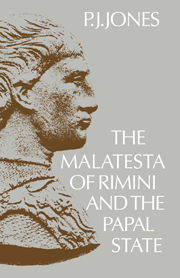Book contents
- Frontmatter
- Contents
- Dedication
- Preface
- Abbreviations
- Map of Romagna and the Marche in the later Middle Ages
- 1 The Papal State and Romagna in the thirteenth century
- 2 Rimini and the rise of the Malatesta
- 3 From commune to papal vicariate
- 4 Galeotto Malatesta, ‘ecclesie pugil’
- 5 The prime of Malatesta rule: Carlo Malatesta
- 6 The pontificate of Martin V
- 7 Sigismondo Pandolfo Malatesta, ‘fex Italiae’
- 8 The papal reconquest
- 9 The government of the Malatesta: I. The papal vicariate
- 10 The government of the Malatesta: II. The signoria
- Appendix
- Bibliography
- Index
6 - The pontificate of Martin V
Published online by Cambridge University Press: 23 December 2009
- Frontmatter
- Contents
- Dedication
- Preface
- Abbreviations
- Map of Romagna and the Marche in the later Middle Ages
- 1 The Papal State and Romagna in the thirteenth century
- 2 Rimini and the rise of the Malatesta
- 3 From commune to papal vicariate
- 4 Galeotto Malatesta, ‘ecclesie pugil’
- 5 The prime of Malatesta rule: Carlo Malatesta
- 6 The pontificate of Martin V
- 7 Sigismondo Pandolfo Malatesta, ‘fex Italiae’
- 8 The papal reconquest
- 9 The government of the Malatesta: I. The papal vicariate
- 10 The government of the Malatesta: II. The signoria
- Appendix
- Bibliography
- Index
Summary
The Great Schism is commonly seen as the darkest period in the history of the Papal State, an interregnum of impoverishment, debility and decay. That the papacy had to fight for recognition of its authority, and conciliate the power of lords and communes was certainly characteristic of the time. But it is not easy to show that such conditions were greatly different from those prevailing before or after the legation of Albornoz, or that they were insuperable. If, during the Schism, the office of rector was burdensome, or taxes difficult to collect, the elements of provincial government survived intact, even though abuses were grave and needed time to eradicate. Boniface IX in particular was successful in asserting papal authority, and could be described at the end of his pontificate as ruling ‘like a strict emperor’. His achievement, it is true, must be largely explained by his liberality, more particularly his readiness in granting both to cities and signori the authority of temporal vicariate, which normally bestowed ‘auctoritate apostolica’ without the express assent of the cardinals, became most widespread under him. Not only did earlier grantees continue to hold the title. New claimants also appeared, and among them some of the greatest papal cities: Ascoli, Fermo, Bologna, Città di Castello. Most numerous, however, were lords: vicar-despots, whose depredations of pope and people were denounced by some contemporaries as bitterly as the tyrants of Dante's day.
- Type
- Chapter
- Information
- The Malatesta of Rimini and the Papal State , pp. 149 - 175Publisher: Cambridge University PressPrint publication year: 1974



